History
With the construction of Rome–Naples Direttissima, it was decided to build a through railway ("Passante"), partly on the surface and partly underground, directly connecting the line from Salerno with the line to Rome, without the need to reverse trains. The line would also allow the construction of several railway stations in order to create an urban metropolitan service.
Although work started in 1906, it was not opened until 20 September 1925 due to delays in completing the work, mainly as a result of World War I and the hilliness of the route. The railway consists of three stations outside the city of Naples in Pozzuoli, Giugliano (its station, Giugliano-Qualiano is some distance from the centres of both Giugliano and Qualiano) and Quarto and six in the city at Napoli Garibaldi, Cavour, Montesanto, Amedeo, Chiaia and Fuorigrotta. The entire line was double track and electrified with 650 V DC third rail.

World War I, also known as the First World War or the Great War, was a global war originating in Europe that lasted from 28 July 1914 to 11 November 1918. Contemporaneously described as "the war to end all wars", it led to the mobilisation of more than 70 million military personnel, including 60 million Europeans, making it one of the largest wars in history. It is also one of the deadliest conflicts in history, with an estimated nine million combatants and seven million civilian deaths as a direct result of the war, while resulting genocides and the 1918 influenza pandemic caused another 50 to 100 million deaths worldwide.

Pozzuoli is a city and comune of the Metropolitan City of Naples, in the Italian region of Campania. It is the main city of the Phlegrean Peninsula.

Giugliano in Campania[dʒuʎˈʎaːno iŋ kamˈpaːnja], also known simply as Giugliano, is a city and comune in the Metropolitan City of Naples, Campania, Italy. As of 2017, it had some 124,000 inhabitants, making it the most populated Italian city that is not a provincial capital.
In 1927 the names of the stations of Chiaia and Fuorigrotta were changed to respectively in Mergellina and Campi Flegrei. In the same year the Direttissima was completed connecting to the metropolitana near Villa Literno station and the stations of Bagnoli and Gianturco were opened. In 1929 the station of Piazza Leopardi was opened.
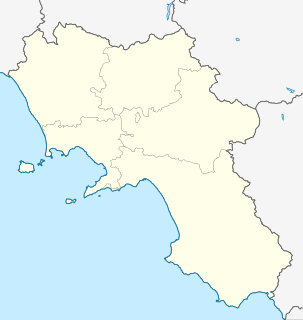
Napoli Mergellina railway station serves the city and comune of Naples, in the region of Campania, Southern Italy. Opened in 1925, it is the third most important railway station in Naples, after Napoli Centrale and Napoli Campi Flegrei. It also forms part of the Villa Literno–Napoli Gianturco railway.
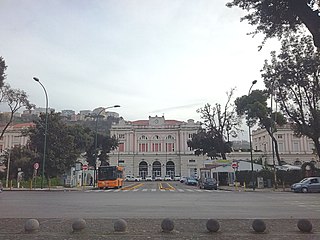
Napoli Campi Flegrei railway station serves the city and comune of Naples, in the region of Campania, southern Italy. Opened in 1925, it is the second most important railway station in Naples, after Napoli Centrale. It also forms part of the Villa Literno–Napoli Gianturco railway.
In 1935, the line was electrified with standard Italian Railways 3 kV DC Overhead Lines, a new station was opened at Cavalleggeri d'Aosta and the station at Piazza Garibaldi (beneath Napoli Centrale) was rebuilt.
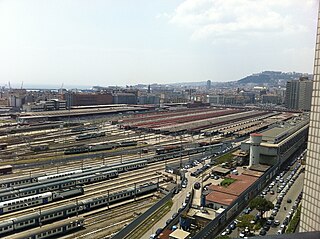
Napoli Centrale is the main railway station in the city of Naples and in southern Italy and the sixth largest station in Italy in terms of passenger flow with an annual ridership of 50 million. It is located next to Piazza Garibaldi to the east of the old city. It is the primary rail terminus and station for Naples, and serves Trenitalia national railways and EAV and has an underground section known as Stazione di Napoli Piazza Garibaldi, which is served by the metropolitan trains of the line 2.
Today the metropolitan trains of the line 2 operates between Gianturco to Pozzuoli on the line. Some of them go further to Castellammare di Stabia, Formia, Salerno and Santa Maria Capua Vetere. Until 2009, the stations of Piazza Garibaldi, Mergellina and Campi Flegrei were also served by long-distance trains, but this severely interfered with the suburban services.

Castellammare di Stabia is a comune in the Metropolitan City of Naples, Campania region, in Italy. It is situated on the Bay of Naples about 30 kilometres southeast of Naples, on the route to Sorrento.

Formia is a city and comune in the province of Latina, on the Mediterranean coast of Lazio (Italy). It is located halfway between Rome and Naples, and lies on the Roman-era Appian Way. It has a population of 38,095.

Salerno is an ancient city and comune in Campania and is the capital of the province of the same name. It is located on the Gulf of Salerno on the Tyrrhenian Sea. The city is divided into three distinct zones: the medieval sector, the 19th century sector and the more densely populated post-war area, with its several apartment blocks.
This page is based on this
Wikipedia article Text is available under the
CC BY-SA 4.0 license; additional terms may apply.
Images, videos and audio are available under their respective licenses.

The Naples Metro is the rapid transit system serving the city of Naples, Italy. The system comprises three underground rapid transit lines.
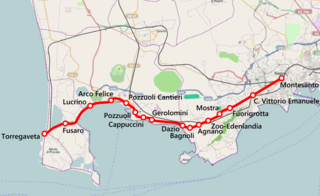
The Cumana railway is a commuter railway in Campania, southern Italy, connecting Naples by two separate routes with Torregaveta, near Cuma in the town of Bacoli. It passes through Pozzuoli and the volcanic Campi Flegrei area. The line was built and run by the Società per le Ferrovie Napoletane, founded in 1883, and is now operated by the EAV company.
Running beneath the Italian city of Naples and the surrounding area is an underground geothermal zone and several tunnels dug during the ages. This geothermal area is present generally from Mount Vesuvius beneath a wide area including Pompei, Herculaneum, and from the volcanic area of Campi Flegrei beneath Naples and over to Pozzuoli and the coastal Baia area. Mining and various infrastructure projects during several millennia have formed extensive caves and underground structures in the zone.
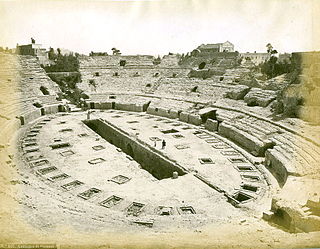
The Flavian Amphitheater, located in Pozzuoli, is the third largest Roman amphitheater in Italy. Only the Roman Colosseum and the Capuan Amphitheater are larger. It was likely built by the same architects who previously constructed the Roman Colosseum. The name Flavian Amphitheater is primarily associated with the Roman Colosseum.

Line 2 is a commuter rail service operated by Trenitalia in the city of Naples, Italy. It connects 12 stations.
The Rome–Formia–Naples railway—also called the Rome–Naples Direttissima in Italian –is part of the traditional main north-south trunk line of the Italian railway network. It was opened in 1927 as a fast link as an alternative to the existing Rome–Naples via Cassino line, significantly reducing journey times. High-speed trains on the route use the parallel Rome–Naples high-speed railway, which was partially opened in December 2005, and fully in December 2009.
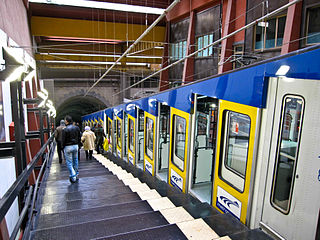
The Montesanto Funicular, is a funicular railway line that forms part of the public transport system for the city of Naples, Italy. Opened in 1891, the Montesanto Funicular carries over 4 million passengers per year.

Milano Porta Garibaldi is a major railway station in the Italian city of Milan, located just to the north of the neighbourhood known as Porta Garibaldi. Porta Garibaldi is the city's main station for commuter traffic with 25 million passengers annually, although it is second to Centrale station considering total passenger traffic. The station is located on Piazza Sigmund Freud.
Centostazioni S.p.A. is a subsidiary of Italian holding company Ferrovie dello Stato. The company was created to redevelop and manage 103 medium-sized Italian railway stations.

Formia-Gaeta railway station, previously named Formia railway station, serves the cities and comunes of Formia and Gaeta, in the region of Lazio, central Italy.

Taranto railway station is the main station serving the city and comune of Taranto, in the region of Apulia, southern Italy. Opened in 1868, it forms a junction between three main lines, from Bari, Brindisi and Reggio di Calabria, respectively. It is also a terminus of a secondary line, the Bari–Martina Franca–Taranto railway.
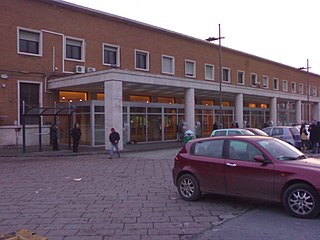
Caserta railway station serves the city and comune of Caserta, in the region of Campania, southern Italy. Opened in 1843, it forms the junction between the Rome–Cassino–Naples railway and the Naples–Foggia railway.

Napoli Piazza Amedeo is an underground rail station on the Villa Literno line in Naples, Italy.

Naples Metropolitan Railway service are two independent companies that operate a commuter rail system in Naples. The first one, Trenitalia, operates line 2 from Pozzuoli Solfatara to Gianturco station in East of Naples. The other one, EAV, operates the Circumvesuviana, Cumana, Circumflegrea and MetroCampania NordEst. In Italy, Naples is the only city possessing two independent metropolitan railway service companies.
FS class E.420 locomotive was a third rail electric locomotive built for the operation of the Milan - Gallarate - Varese railway in Italy.



















